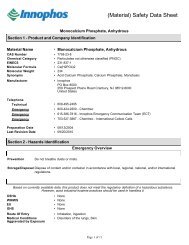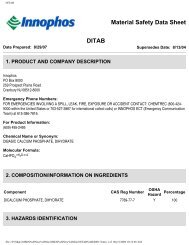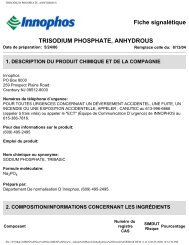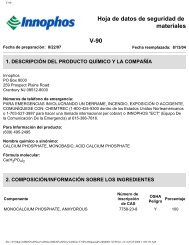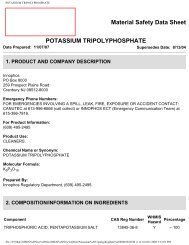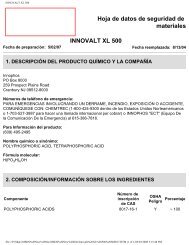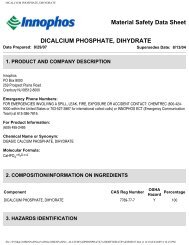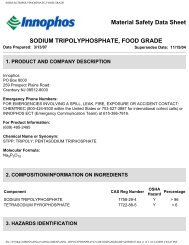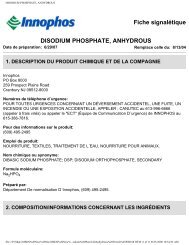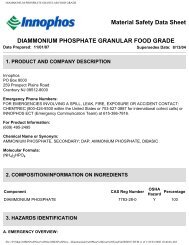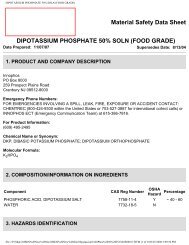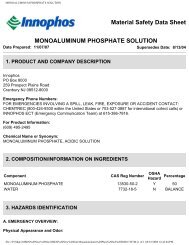Polyphosphoric Acid 105 to 118% - Innophos
Polyphosphoric Acid 105 to 118% - Innophos
Polyphosphoric Acid 105 to 118% - Innophos
Create successful ePaper yourself
Turn your PDF publications into a flip-book with our unique Google optimized e-Paper software.
Section 3 - Composition/Information on IngredientsHazardous ComponentsChemical Name CAS %(weight) UN;EINECS LD50/LC50EU Classification& R Phrases<strong>Polyphosphoric</strong> acid 8017-16-1 100% 232-417-0 NDA NDA NDAAccording <strong>to</strong> the Globally Harmonized Standard for Classification and Labeling (GHS) this product is consideredhazardous. Under United States Regulations (29 CFR 1900.1200 - Hazard Communication Standard), this product isconsidered hazardous. In Canada, the product mentioned above is considered hazardous under the Workplace HazardousMaterials Information System (WHMIS). This product is considered dangerous according <strong>to</strong> the European Directive67/548/EEC.OtherSection 4 - First Aid MeasuresInhalationSkinEyeIngestionNotes <strong>to</strong> PhysicianOther Information▪ Administer oxygen if breathing is difficult. Do not use mouth-<strong>to</strong>-mouth method if victiminhaled the substance; give artificial respiration with the aid of a pocket maskequipped with a one-way valve or other proper respira<strong>to</strong>ry medical device. Give artificialrespiration if victim is not breathing. Move victim <strong>to</strong> fresh air.▪ For minor skin contact, avoid spreading material on unaffected skin. In case of contactwith substance, immediately flush skin with running water for at least 20 minutes.Wash skin with soap and water. Remove and isolate contaminated clothing andshoes. Wash contaminated clothing before reuse.▪ In case of contact with substance, immediately flush eyes with running water for atleast 20 minutes. Seek immediate medical attention, preferably with anophthalmologist. If the physician is not immediately available, eye irrigation should becontinued for an additional 20 minutes. If it is necessary <strong>to</strong> transport the patient <strong>to</strong> aphysician and the eye needs <strong>to</strong> be bandaged, use a dry sterile cloth pad and coverboth eyes.▪ If swallowed give 2-3 glasses of water if victim is conscious and alert. Do not giveanything by mouth <strong>to</strong> an unconscious person. Do NOT induce vomiting. Obtainmedical attention immediately if ingested. Do not use mouth-<strong>to</strong>-mouth method if victimingested the substance. Do not leave victim unattended. To prevent aspiration ofswallowed product, lay victim on side with head lower than waist. Persons attendingthe victim should avoid direct contact with heavily contaminated clothing and vomitus.Wear impervious gloves while decontaminating skin and hair.▪ All treatments should be based on observed signs and symp<strong>to</strong>ms of distress in thepatient. Consideration should be given <strong>to</strong> the possibility that overexposure <strong>to</strong> materialsother than this product may have occurred.▪ Call 911 or emergency medical service. Ensure that medical personnel are aware ofthe material(s) involved and take precautions <strong>to</strong> protect themselves. Keep victim warmand quiet.Section 5 - Fire Fighting MeasuresExtinguishing MediaUnsuitable ExtinguishingMediaFirefighting ProceduresUnusual Fire and ExplosionHazardsHazardous CombustionProducts▪ Not combustible. Use extinguishing media suitable for surrounding fire.▪ None known.▪ Keep unauthorized personnel away.Dike area <strong>to</strong> prevent runoff and contamination of water sources. Dispose of fire controlwater later. Evacuate residents who are downwind of fire. Persons who may have beenexposed <strong>to</strong> contaminated smoke should be immediately examined by a physician andchecked for symp<strong>to</strong>ms of poisoning. The symp<strong>to</strong>ms should not be mistaken for heatexhaustion or smoke inhalation.▪ Not combustible. Under fire conditions, <strong>to</strong>xic, corrosive fumes are emitted.▪ Non-combustible, substance itself does not burn but may decompose upon heating <strong>to</strong>produce corrosive fumes.Page 3 of 13



